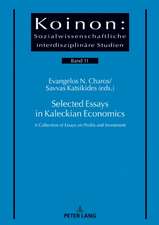Management Control Systems and Cross-Cultural Research: Controlling, Bd. 23
Autor Michael Hanzlicken Limba Engleză Paperback – 30 ian 2015
Preț: 458.72 lei
Preț vechi: 566.33 lei
-19% Nou
Puncte Express: 688
Preț estimativ în valută:
87.79€ • 89.90$ • 73.02£
87.79€ • 89.90$ • 73.02£
Carte disponibilă
Livrare economică 25 februarie-11 martie
Preluare comenzi: 021 569.72.76
Specificații
ISBN-13: 9783844103809
ISBN-10: 3844103805
Pagini: 304
Dimensiuni: 148 x 210 x 19 mm
Greutate: 0.37 kg
Editura: Josef Eul Verlag GmbH
Colecția Controlling, Bd. 23
Seria Controlling, Bd. 23
ISBN-10: 3844103805
Pagini: 304
Dimensiuni: 148 x 210 x 19 mm
Greutate: 0.37 kg
Editura: Josef Eul Verlag GmbH
Colecția Controlling, Bd. 23
Seria Controlling, Bd. 23
Notă biografică
Michael Hanzlick studied business administration from 2001 to 2005 in Regensburg, Leipzig and Taipei, Taiwan. After his studies he worked for a management consultancy and for a medium-sized firm in the area of financing and management control. Between 2010 and 2014 he worked as a research assistant at the Chair of Management Control (Prof. Dr. Rolf Brühl) at ESCP Europe Business School Berlin. In November 2014 he finished his dissertation on management control systems and cross-cultural research obtaining the degree of "Dr. rer. pol.".
Cuprins
1. Introduction1.1. Motivation1.2. Research background and guiding research question1.3. Outline of the thesis2. Fundamental terms and theoretical framework2.1. Culture2.2. Management control systems' framework2.3. Performance measurement, performance evaluation and rewards2.4. Theories3. Research overview and hypotheses3.1. Methodology of literature review3.2. Research overview3.3. Research hypotheses4. Research methodology4.1. Sample4.2. Questionnaire design4.3. Data collection4.4. Variables and measures4.5. Tests of and remedies for measurement error5. Results5.1. Descriptive statistics5.2. Multivariate analysis5.3. Robustness tests5.4. Summary of hypotheses6. Discussion and conclusion6.1. Discussion of results6.2. Contributions to theory and former research6.3. Managerial and practical implications6.4. Limitations6.5. Avenues for future research6.6. Conclusion









